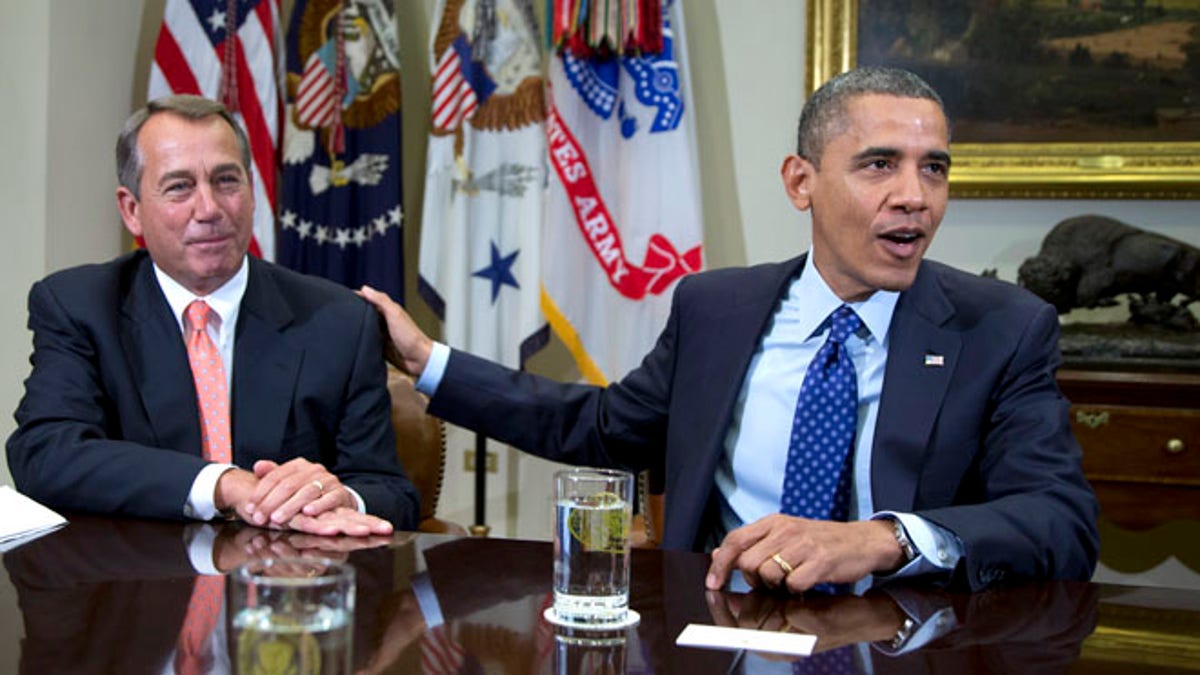
FILE 2012: President Obama acknowledges House Speaker John Boehner of Ohio while speaking to reporters in the Roosevelt Room of the White House in Washington. (AP)
The possibility of Washington failing to avert the double-whammy of tax hikes and spending cuts next month is looking far less remote.
With 24 days remaining to strike a deal, the two sides remain far apart. House Speaker John Boehner claimed Friday that President Obama’s offers are just “more of the same.” Democrats say Republicans have to give more on taxes before they can reach a serious agreement.
Given this divide, it may seem counterintuitive that lawmakers left themselves just two months to negotiate their way out of the crisis – the two months after Election Day and before the Jan 1 deadline.
But the reality is that lawmakers have been trying to strike this kind of a deal for years, and each time ended up pushing off the very toughest decisions to a future date. The current stand-off is the result of these incremental maneuvers and delayed decisions.
The following is a look back at just the last four years of can-kicking, and the moments that put lawmakers in the fiscal pickle they’re in today:
‘Bowles-Simpson’
- Feb. 23, 2009: After winning passage of his $787 billion stimulus bill shortly after taking office, President Obama announces that he’s set the goal of cutting the deficit in half by the end of his first term. The deficit that year would ultimately hit $1.4 trillion.
- Feb. 18, 2010: Obama signs an executive order creating the National Commission on Fiscal Responsibility and Reform, a panel whose goal is to explore deficit reduction. Obama taps former White House Chief of Staff Erskine Bowles, a Democrat, and former Wyoming Sen. Alan Simpson, a Republican, to lead it. In a statement, Obama says Washington has avoided the “tough choices” for “far too long.”
- Dec. 1, 2010: After series of meeting and months of preparation, the committee produces a plan that aims to cut the deficit by $4 trillion over 10 years. It includes a mix of spending cuts and revenue increases.
- Dec. 3, 2010: The deficit commission votes on the plan, with 11 of the 18 members supporting it. That majority, though, is not strong enough to force a vote in Congress on the proposal. Despite statements of support for the plan, it effectively stays on the drawing board.
Bush tax rates, payroll tax cut
- December 2010: As the “Bowles-Simpson” plan fails to get out of committee, lawmakers on Capitol Hill battle over whether and how to extend the expiring Bush-era tax rates. Republicans threaten to block all bills until the issue is settled. In a preview of the debate that will resurface in two years, Republicans want all the rates extended, while Democrats want to increase taxes on top earners.
- Dec. 16, 2010: Congress approves a two-year extension of the Bush tax rates. The package also includes an extension of long-term unemployment aid and a 2-point cut in the Social Security payroll tax rate.
- Feb. 17, 2012: Faced with the expiration of the payroll tax cut, Congress votes again to extend it. As part of the deal, the cut is not offset by budget cuts or tax increases elsewhere. Both the payroll tax rates and Bush tax rates are now on course to expire on Jan. 1, 2013.
Debt ceiling fight
- Summer 2011: Republicans use a looming vote on raising the debt ceiling to demand significant deficit-reduction measures in return. This leads to behind-the-scenes talks between President Obama and House Speaker John Boehner, with talk of a “grand bargain” in the making. Ultimately, those talks fail despite both sides making concessions on tax hikes and entitlement cuts.
- July 31, 2011: The White House and congressional Republicans reach a deal that will allow for a vote on the debt ceiling, in turn avoiding the first-ever U.S. government default. The deal, though, delegates many tough decisions to a new committee.
- Aug. 2: Hours before the Treasury is expected to exhaust ways to pay all the nation’s bills, Obama signs the Budget Control Act, which had just passed Congress, into law. The law, in its first phase, calls for $900 billion in spending cuts over the next 10 years. But it also tasks a new “super committee” with finding another $1.2 trillion-$1.5 trillion in deficit reduction by the end of the year. As an incentive for the committee to reach a deal, lawmakers included in the package a provision that would trigger sweeping defense and other domestic cuts if the committee’s recommendations are not finished and approved by the end of the year.
Super committee failure
- Sept. 8, 2011: The 12-member, bipartisan super committee holds its first meeting, with lawmakers stressing the importance of reaching a deal.
- Nov. 21, 2011: Just two months after they started, leaders of the so-called super committee announce they are unable to reach an agreement, with disputes over tax hikes and entitlement spending keeping the two sides apart. The super committee quietly dissolves. There is no deal. The automatic spending cuts are set in motion. The first wave of $109 billion in cuts is set to kick in starting Jan. 2, 2013.
Fiscal crisis talks
- November/December 2012: After effectively hitting pause on all talks while the presidential and congressional campaigns played out, lawmakers scramble in the lame-duck session of Congress to avert the spending cuts and tax hikes that are now set in place by law. Though some hoped the results of the election would crystallize negotiations and make way for a smooth compromise, this does not happen.
Kicking the can … again?
- 2013, and beyond: If there is a deal, it’s possible lawmakers will again punt the toughest decisions to 2013 and beyond. Indeed the White House proposal, which Republicans have rejected, calls for discussions about tax reform and entitlement cuts to take place as part of a “Stage 2.”




